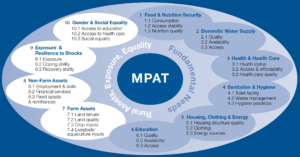Developing a Thematic Indicator for Rural Poverty Assessment (MPAT)
 The Multidimensional Poverty Assessment Project was a collaborative, international initiative to develop, test, and pilot a new tool for local-level rural poverty assessment. The work was supported by IFAD and guided by a Sounding Board of experts from IFAD, other United Nations agencies, international and regional organizations, and universities around the world, with the majority of its members coming from the Asia region where we developed and tested the tool in China and India. Surveys (household and village level) were developed and tested in an iterative and participatory fashion, as was the indicator structure used to aggregate sub-components and components. The resulting Multidimensional Poverty Assessment Tool (MPAT) provides an assessment, an overview, of ten dimensions central to rural livelihoods, highlighting where additional support or interventions are likely to be most needed. The tool was designed to be universal enough to be relevant to most rural contexts around the world, yet specific enough to provide project managers and others a detailed overview of key dimensions relevant to rural poverty reduction efforts. MPAT was independently evaluated by the European Commission Joint Research Center and a working-paper version of MPAT User’s Guide was released in 2009 as well as the 2009 MPAT Book, which provides a detailed description of why and how the tool was developed. MPAT’s theoretical foundations are described in a 2010 article in Development and Practice.
The Multidimensional Poverty Assessment Project was a collaborative, international initiative to develop, test, and pilot a new tool for local-level rural poverty assessment. The work was supported by IFAD and guided by a Sounding Board of experts from IFAD, other United Nations agencies, international and regional organizations, and universities around the world, with the majority of its members coming from the Asia region where we developed and tested the tool in China and India. Surveys (household and village level) were developed and tested in an iterative and participatory fashion, as was the indicator structure used to aggregate sub-components and components. The resulting Multidimensional Poverty Assessment Tool (MPAT) provides an assessment, an overview, of ten dimensions central to rural livelihoods, highlighting where additional support or interventions are likely to be most needed. The tool was designed to be universal enough to be relevant to most rural contexts around the world, yet specific enough to provide project managers and others a detailed overview of key dimensions relevant to rural poverty reduction efforts. MPAT was independently evaluated by the European Commission Joint Research Center and a working-paper version of MPAT User’s Guide was released in 2009 as well as the 2009 MPAT Book, which provides a detailed description of why and how the tool was developed. MPAT’s theoretical foundations are described in a 2010 article in Development and Practice.
